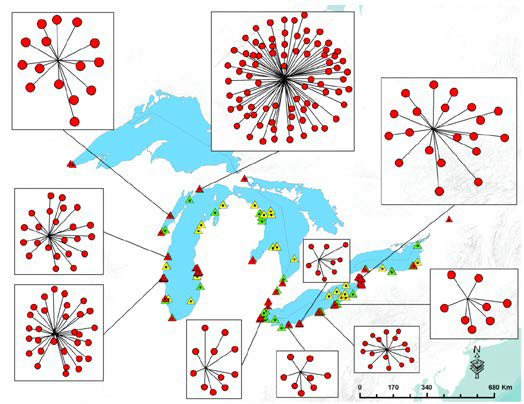Mussels are widely used as sentinel organisms to monitor chemical pollution in the aquatic environment. Mussels are filter feeding, sessile bottom dwellers that bioaccumulate many contaminants and provide time-integrated observations of chemical contamination in the ambient environment.
NOAA’s Mussel Watch Program initiated monitoring in the Great Lakes in 1992, collecting zebra and quagga mussels at sites ranging from as far west as Duluth, Minnesota, across the Great Lakes, and eastward to Cape Vincent, New York. Chemical analyses of the contaminants in mussel tissue provide a wealth of environmental monitoring data that can be used to: 1) track: the status and trends of 150+ contaminants in the Great Lakes, 2) track the effectiveness of pollution prevention legislation and remediation programs, and 3) assess the environmental impacts in the event of catastrophic environmental disasters.
After expanding its monitoring to Great Lakes Areas of Concern with previous GLRI support, Mussel Watch is now focusing on contaminants of emerging concern in Great Lakes fish and wildlife. New emphasis is now being place on evaluating exposure and bioeffects of emerging contaminants to mussels co-located with other projects that address contaminants of emerging concern.
For more information, please visit the NCCOS Great Lakes Mussel Watch project page, or check out an information on Caged Mussel Source Tracking 2013.

Mussel Watch has expanded to over 200 sites basin-wide:
Red circles = river-harbors
Green squares = nearshore lake
Yellow triangles = offshore open lake
Mussel Watch is part of the Invasive Mussels Collaborative.
Funding:
FY 2021: $150,000
FY 2020: $250,000
FY 2019: $497,000
FY 2018: $650,000
FY 2017: $450,000
FY 2016: $400,000
FY 2015: $448,000
FY 2014: $428,000
FY 2013: $374,000
FY 2012: $394,000
FY 2011: $414,000
FY 2010: $200,000
Contacts:
Kimani.Kimbrough@noaa.gov


